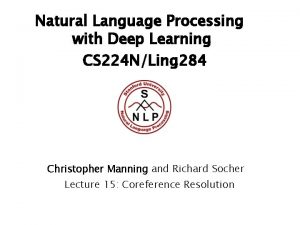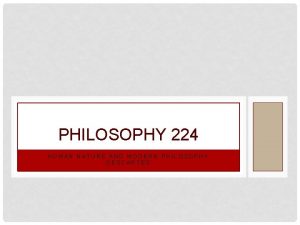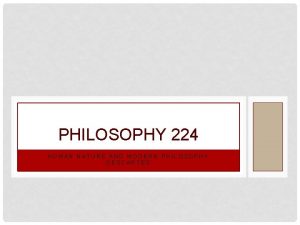PHILOSOPHY 224 HOLMSTROM DO WOMEN HAVE A DISTINCT








- Slides: 8

PHILOSOPHY 224 HOLMSTROM, “DO WOMEN HAVE A DISTINCT NATURE? ”

AN OPERATIVE SUSPICION • Holmstrom begins by noting that women have good reason to be suspicious of attempts to specify a distinct, feminine nature (to essentialize them) esp. when that essentialism is biological in nature. • After all, the presumed norm of such attempts is usually a masculine one. • Even when there is talk of “different but equal, ” the fact remains that the characteristics usually attributed to the two sexes are evaluated differently (289). • She makes the important observation that if there are differences, they are differences from one another, not from one standard/ideal.

METAPHYSICAL REALISM • Given this suspicion, Holmstrom is going to dispute the conclusions of sociobiologists like Wilson. • In a move that we saw in Bracken’s discussion of race, in refusing a basically empiricist approach, Holmstrom takes up a quasi-rationalist position. • She offers a version of metaphysical realism: essences exist as underlying law-like structures with an important explanatory function. • She explains how she's using the term essence by referring to biology, in particular theoretical disagreements motivating different taxonomic schemes (290 -1).

SOCIAL FORCES • The essences Holmstrom specifies leave a great deal of room for the influence of social forces, and on this basis, Holmstrom insists that, though there are fundamental differences between men and women, these differences are determined primarily by social forces (290). • Holmstrom recognizes that the question of the relation between nature and behavior ultimately settles on the psychological (the “interface” between the two. ) • What she wants to know is, “Are there psychological differences between men and women? ” and “What is the source of these differences? ”

2 QUESTIONS • After noting some conceptual limitations of many studies of this issue (statistics, differences relative to similarities, theoretical suppositions), Holmstrom answers the first question by accepting without argument the claim that there a significant number of general personality differences between men and women. • The second question gets most of her attention. Acknowledging the speculative character of her assertions, Holmstrom argues that these differences are caused by predominantly social factors rather than biological/genetic ones.

JUSTIFICATION • In support of her claim, Holmstrom points to a number of justifying resources. • First, she highlights a range of experimental results (295) which offer confirmation of the significance of social factors. • Second, she looks to the findings of anthropology which reveal significant cross-cultural differences in sexed personality. • The conclusion of this analysis is that we have clear evidence for social determination, and no clear evidence for significant biological determination • Read summary and inferences (296 -7).

SEX/GENDER • This analysis leads Holmstrom to a distinction that has been crucial for feminism: the sex/gender distinction (298). • Holmstrom goes on to provide a possible theoretical foundation for her analysis (historically and socially specific forms of human nature/ woman's nature).

IMPLICATIONS • What are the implications if there are real, socially determined differences? 1. Not every women has to embody the feminine type. 2. Indeed, rather than there being a type, the ‘nature of men and women’s is best understood as a "cluster concept. ” 3. This approach makes it much easier to understand the (relatively) frequent disconnect between sex and gender (for example, as experienced by transgendered individuals). 4. There are no evaluative implications of the differences that can be specified between the male and female nature clusters.















